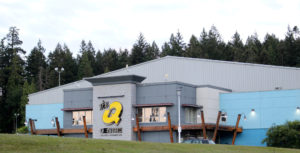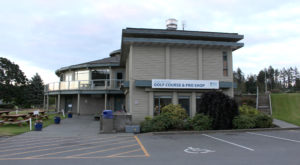June 14, 2018 Annual General Meeting:
West Shore Parks & Rec owners disband their board

Effective immediately, the five municipal owners (Langford, Colwood, View Royal, Metchosin and Highlands) will run the show. ‘Time to push the reset button’, was a phrase used often this evening, June 14. The five mayors will be represented by the Chief Administrative Officers (CAOs) of their municipalities.
It’s a rather unique setup, an interim board to — in part — carry the WSPR entity relatively intact through the fall municipal election period (during which mayors will be otherwise occupied) and into the 2019 home stretch of the current agreement. The current West Shore Parks & Recreation ownership agreement expires in April 2019.
Rumblings for change began in the last few years and intensified this year, as Langford with its seven new recreational facilities in seven years began to feel as though its annual contribution to WSPR was becoming out of balance with the benefits gained for Langford residents. At tonight’s WSPR AGM Langford Councillor Denise Blackwell said: “Langford pays a great deal and we also fund our own facilities. We’ve felt an inequity in the amount that Langford is paying for recreation,” she said. And joining the chorus of similar statements around the table: “It’s not about the members of the board or staff – it’s owners with the most issues,” said Blackwell.

The five mayors running this show are Stew Young (Langford), Carol Hamilton (Colwood), David Screech (View Royal), John Ranns (Metchosin), and Ken Williams (Highlands). Until last year the Juan de Fuca Electoral Area (JDFEA) was also a member, but JDFEA Mike Hicks managed to get his area out of the deal over evidence of minimal usage by JDFEA residents.
The current five mayors met mid-May to discuss the findings and recommendations in a report known as ‘the Huggett report’ (by consultant Jonathan Huggett) which was commissioned for $25,000 to review the terms of reference and find a way forward for recreation in the west shore that is presumably more equitably contributed to.
“The Huggett Report takes us one step forward,” said Metchosin Mayor John Ranns during the AGM. “It’s a preliminary report and we’re following the footsteps. It’s nothing against the board and good works that people have done.” Ranns said that the interim board is “the only means we could find” to break the current impasse of budget and funding issues.
In part, those issues are underscored by staff that may have been left rudderless for vision and direction – perhaps by a combination of ownership being one-step-removed (mayors were not members of the WSPR board), extended absence of a senior staff person away for health reasons, and perhaps a lack of organization around ‘moving forward’ in various levels of business development.
For Ranns to say this evening that “we fired ourselves” was a bit of humble pie, as mayors now fully hold the reins through their CAOs.
Highlands Mayor Ken Williams said “the board did the best they could do with the tools given to them”. He said the new arrangement was a way for achieving “maximum potential for this facility”.
At tonight’s WSPR AGM — held in the Fieldhouse behind the Juan de Fuca Rec Centre – board chair Ed Watson clearly stated that he felt that collapsing the current board was “about money”. Indeed, Langford in particular has been looking for a new formula for a couple of years now, one that will see its annual contribution (requisition) to WSPR be more representative of how much benefit Langford residents get from the facility. Now it sounds like all five member municipalities are on board for something equitable.
Colwood Mayor Carol Hamilton tonight said “it’s about the ownership and productivity, and how we support this facility to see it thrive”, adding her support for CAOs to run the ship while mayors are busy during the election period.
The other aspect about money has been a revenue shortfall, which municipalities flagged as a problem and essentially (through objection by member councils) froze the WSPR budget at 2016 levels. Staffing costs have gone up, so have (or soon will be) some of the admission and facility fees. A little revenue burst was seen in the last year or so from adjusting the rental arrangements of the LED display sign at the roadside. But use of the curling rink and Q Centre and many of the field areas have been underutilized, perhaps through a lack of leadership, vision or operational know-how.
It now seems long ago (though it was only March 1) that Colwood Mayor Carol Hamilton issued a surprisingly forthright statement including that “Colwood is fighting for West Shore Parks and Recreation’s survival by advocating for a sustainable financial plan. We risk losing West Shore Parks and Recreation if owner municipalities act in their own interests rather than honouring their contractual obligations.” Much of that seemed targeted toward Langford.
But at tonight’s WSPR AGM it was pretty much ‘smiles all around’, with all five municipalities on board – if not actually excited – to be going into a transitional phase in which they feel they will have an opportunity to rethink the financial model for delivery of recreation services in their five west shore areas.
Recreation is understood among most of the WSPR community leadership as well as users as more than just the facilities themselves. The rec centre, arenas, pool, golf course, seniors centre and other amenities are the ways and means for community groups, sports teams, and many sectors of the community to gather, be active, recreate and learn.

While disbanding of the WSPR volunteer board of 14 people (elected reps from each municipality plus non-elected appointees) was done as graciously as could be hoped for, it was a clear reclaiming of power by the top levels of municipal government. The CAOs (the most senior staff person of each municipalities) have already rolled up their sleeves and begun the necessary processes for discussions and moving forward. There’s no moss on this rolling stone that will see new decisions for recreation in the west shore being made by new councils after the October 2018 election.
While the faces of the five councils are likely to be refreshed in October 2018, few if any of the current five mayors as incumbents are expected to fail at re-election. So this period where senior municipal staff are effectively in charge of the region’s largest recreational facility for at least the next six months, it’s likely that the mayors chose this method of disbanding their volunteer board as a way to maintain control, until the agreement can be rewritten ahead of April 2019 with a rebalancing of the financial requirements that will be expected of each municipality after that.
At present, requisitions into WSPR are paid strictly on population count. Langford is growing fast but can likely profess that fewer uses of the Juan de Fuca Rec Centre and adjoining facilities are by Langford residents, many of whom are staying closer to home using newer and a different range of facilities. In the 2017 WSPR annual report it shows a total population for the five-municipality region being just under 70,000. Of that, Langford has 50.7% of that count, with Colwood at 24.2%, View Royal 14.9%, Metchosin 6.8% and Highlands 3.2% (JDFEA had 0.2% population count in that formula until leaving the arrangement). Population growth for that combined group of municipalities was 32.2% over 10 years (2006 to 2016).

Expenditures based on the 2016 (most recently approved) budget were $11,643,688. So that leaves a difference (after incoming municipal requisitions, and depending on which year’s figures are crunched) of about $6,696,149. That’s where fee-based services come in, to provide the rest.
The biggest fee-based revenue generators in terms of percentage contribution to the revenues, are aquatics (7.89%), food and beverage services (6.55%), licensed care (6.55%), fitness and wellness (5.84%), and the Q Centre mostly anchored by The Shamrocks and The Grizzlies sports teams (4.93%). That’s followed by sports and curling, JdF Arena, Preschool to Youth, Arts & Culture, golf, seniors centre, and community recreation/development.
Earlier this year a projected transfer of $721,455 was expected to be needed this year from the capital surplus (a fund generally used for larger maintenance projects and new initiatives). The WSPR sees value in continuing to subsidize areas of its operations, including a subsidy in 2018 of $347,135 to operate the JdF arena ($4.26 per user/year), $289,462 to operate the swimming pool ($2.07 per usage/year), the Q Centre with a subsidy of $164,974 ($2.10 per usage/year), and the curling rink ice with a subsidy of $103,866 ($20.61 per usage/year).
The meeting wrapped up with a relatively tense debate about whether one of the five CAOs would represent the WSPR Society at the Greater Victoria Labour Relations Association (GVLRA) public sector employer’s bargaining agency. WSPR board chair Ed Watson did remind the gathered mayors that an elected official is to participate at GVLRA meetings. Mayor Ranns said “leave it to the CAOs to figure it out”, in that they would check with GVLRA to see if one of the interim reps (CAOs) could attend GVLRA meetings instead of one of the mayors. Mayor Screech said he felt it could be a conflict for a CAO (staff) to participate in labour negotiation discussions.
Back to the Langford breaking news page | Back to the Colwood breaking news page | Back to the main page

